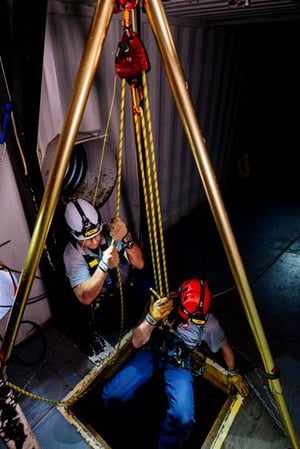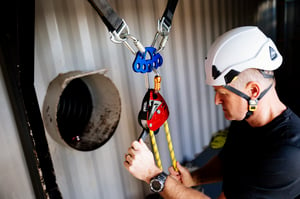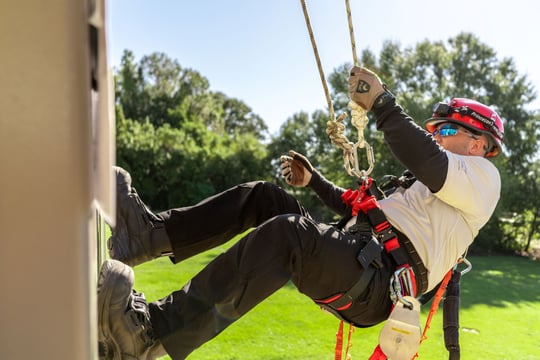Medical calls make up the majority of contacts with the public for emergency responders. Technical rescue calls make up a much smaller segment of emergency response. While the response numbers are at opposite ends of the response spectrum, they are invariably tied together.
 Oftentimes, technical rescue responses originate after medical responders determine that their patient is in an untenable position. Other times, we just need more muscle than the people we responded with can muster. That is where one Western New York Ambulance Service melded EMS response with rope rescue ingenuity to provide a positive outcome for a 600-lb. bariatric patient.
Oftentimes, technical rescue responses originate after medical responders determine that their patient is in an untenable position. Other times, we just need more muscle than the people we responded with can muster. That is where one Western New York Ambulance Service melded EMS response with rope rescue ingenuity to provide a positive outcome for a 600-lb. bariatric patient.
Wellsville Volunteer Ambulance Corps takes the concept of self-sufficiency seriously. Located in rural western New York, 15 miles north of the Pennsylvania border, they are remote, but they know how to get things done.
In early August 2024, Wellsville was hosting Roco Rescue and Roco Chief Instructor Bob Kauer for four days of Rope Rescue and Confined Space training. At 4PM on the second day of class, EMS was dispatched for a man down in a residence. That call triggered a multi-faceted response as responders quickly learned that a 600-lb. man had been down on the floor since 9:30 the previous night. The race was on to get the patient in respiratory distress to definitive care.
While EMS responders started patient care, students from the Roco class quickly broke down rescue gear and loaded on to response vehicles. This included Roco Instructor Kauer who was happy to lend his experience and training to the response.
The first obstacle was getting the patient off the floor. He was unable to assist rescuers who were now faced with lifting the 600-lb. man. A stokes basket was brought into the living room where the man was located. A group of ten rescuers was able to slide four sheets under the patient, and a couple of additional pieces of webbing were positioned for better handling of the patient. The man was then lifted into the basket stretcher.
While responders were moving the man into the basket, rescuers were working to build a system to move the patient to the waiting ambulance. Chainsaws were fired up and the front door was rapidly converted to a garage door to make room. A support beam for the porch had to be removed, requiring rescuers to place spot shores under the porch to provide for patient and rescuer safety during the move. Ramps were built using plywood and 4” x 4” lumber to remove the stairs from the equation.
Meanwhile, outside the house, rescuers, including Chief Kauer, established an elevated anchor on a large tree. A CMC Clutch by Harken became the progress capture device in a 5:1 horizontal mechanical advantage system. Quickly extended into the residence, the system was attached to the top of the stokes basket and tensioned. The haul team began to move the patient in the stokes basket across the floor and the emergency ramp system they had constructed, which allowed the victim to slide straight onto the gurney.
The patient was loaded into the ambulance and delivered to the hospital for definitive care in less than an hour, which was excellent.
Roco extends our congratulations to Wellsville (NY) Volunteer Ambulance Corps for a well planned and executed rescue. Good job!!


 Jackson, Mississippi is a burgeoning metro area with over 600,000 residents. Interstate highways busily crisscross the city. In the early evening of April 30, 2024, emergency responders found themselves planning how to recover the body of a man that had been missing for a month.
Jackson, Mississippi is a burgeoning metro area with over 600,000 residents. Interstate highways busily crisscross the city. In the early evening of April 30, 2024, emergency responders found themselves planning how to recover the body of a man that had been missing for a month. Three rescuers scrambled down the slope to assist local law enforcement. The victim was placed in a body bag and securely packed in the SKED stretcher. Meanwhile, topside rescuers used the extended anchor to establish a haul system using a Petzl Maestro and a newly acquired CMC Capto in a 3:1 Z-Rig configuration.
Three rescuers scrambled down the slope to assist local law enforcement. The victim was placed in a body bag and securely packed in the SKED stretcher. Meanwhile, topside rescuers used the extended anchor to establish a haul system using a Petzl Maestro and a newly acquired CMC Capto in a 3:1 Z-Rig configuration. So often, the outcome of our rescue response is predetermined. Our actions provide closure rather than the excitement of a rescue. However, we can take solace in knowing that the professionalism and preparedness of local responders gave a local family the opportunity to say goodbye.
So often, the outcome of our rescue response is predetermined. Our actions provide closure rather than the excitement of a rescue. However, we can take solace in knowing that the professionalism and preparedness of local responders gave a local family the opportunity to say goodbye. To decide whether the Maestro would be a good choice for an urban/industrial rescue team, let’s look at why a mountain rescue team would choose the Maestro. Mountain and back country rescue teams covet light weight, easily transportable equipment. Smaller diameter ropes, lightweight carabiners, pulleys and rope grabs are the norm when you must pack in your own gear. Anyone that has hefted a Petzl Maestro would never consider the device to be petite. At nearly two and a half pounds, the device is far from the featherlight kit usually found in back country response packs. Yet despite the rotund nature of the device, it continues to find its way into the equipment caches that ride on the shoulders of mountain rescue teams. That says a lot about how these teams feel about the Maestro’s performance.
To decide whether the Maestro would be a good choice for an urban/industrial rescue team, let’s look at why a mountain rescue team would choose the Maestro. Mountain and back country rescue teams covet light weight, easily transportable equipment. Smaller diameter ropes, lightweight carabiners, pulleys and rope grabs are the norm when you must pack in your own gear. Anyone that has hefted a Petzl Maestro would never consider the device to be petite. At nearly two and a half pounds, the device is far from the featherlight kit usually found in back country response packs. Yet despite the rotund nature of the device, it continues to find its way into the equipment caches that ride on the shoulders of mountain rescue teams. That says a lot about how these teams feel about the Maestro’s performance. Mountain rescue teams are also very aware of the corollary between “friction management” and system efficiency. When you are working in small teams with potential for lots of friction running over rock and dirt, a device that can greatly increase friction reduction during hauls is very appealing. The Maestro delivers friction reduction in spades. The faceted sheave in the Maestro delivers up to 95% pulley efficiency.
Mountain rescue teams are also very aware of the corollary between “friction management” and system efficiency. When you are working in small teams with potential for lots of friction running over rock and dirt, a device that can greatly increase friction reduction during hauls is very appealing. The Maestro delivers friction reduction in spades. The faceted sheave in the Maestro delivers up to 95% pulley efficiency.







